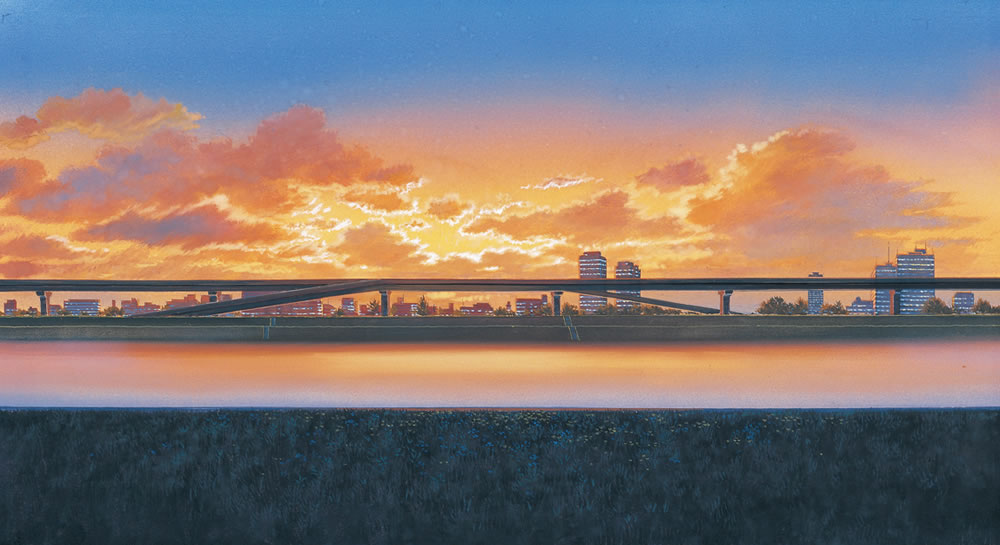The fifth “PIGMENT COLOR PHILOSOPHY” talk session featuring a professional color artist as a guest was held at PIGMENT TOKYO, an art materials shop in Shinagawa Ward in Tokyo operated by Warehouse TERRADA, on August 10, 2019. The guest was Nizo Yamamoto, who created background art as an art director for a number of successful animations. In the session entitled Colors of clouds and skies—scenes created by hand painting, Yamamoto talked with Kei Iwaizumi, chief of PIGMENT TOKYO, about clouds and skies, key elements of the backgrounds of animations. Yamamoto also demonstrated how to paint clouds and skies, which gave the audience rare opportunity to see his production process right in front of them.
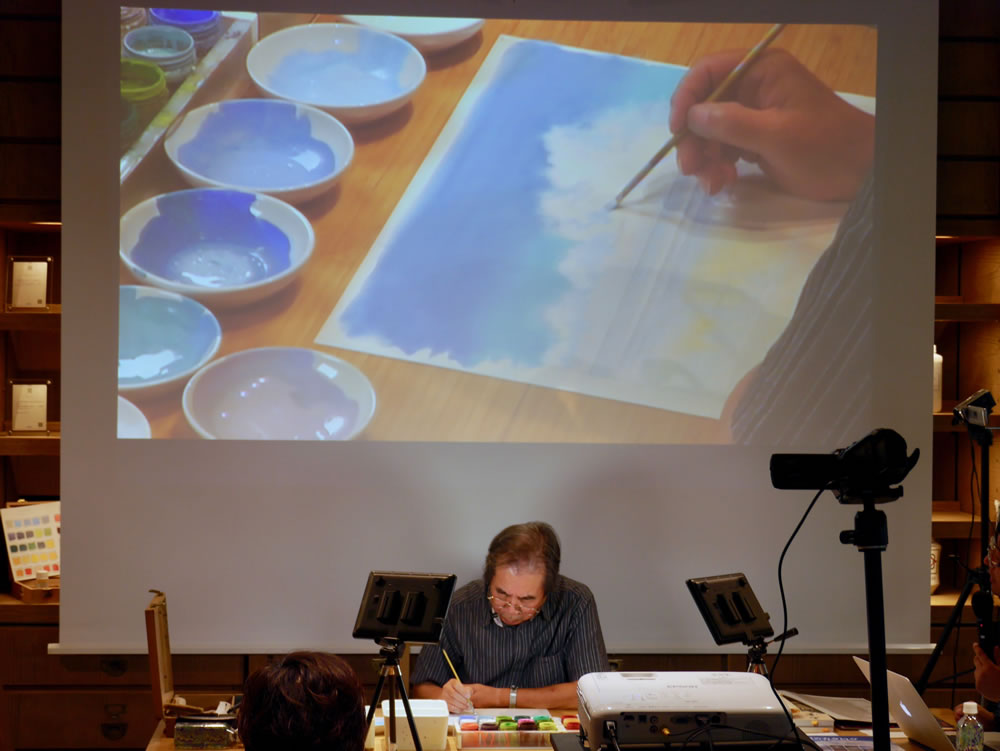 Yamamoto demonstrated how to shade clouds using a light blue paint.
Yamamoto demonstrated how to shade clouds using a light blue paint.
Creating background art for a number of successful animations
The first topic was the Makoto Shinkai’s film Weathering With You released on July 19, 2019. Yamamoto painted the ceiling painting of dragon in Kisho Jinja (weather shrine) that appeared in an important scene of the film. Yamamoto said that he happened to see a ceiling painting of dragon in a hall of Hofuku-ji temple in Soja City, Okayama Prefecture when he visited the temple for another job. As he had been asked to create a ceiling painting for the film, he told Director Shinkai about the painting of dragon. The ceiling painting in the film was inspired by this painting of the temple.
About creating the ceiling painting, Yamamoto said it was difficult. Yamamoto was also responsible for the layout, which was usually drawn by the director or the supervising animator or the key animator. Shinkai told Yamamoto to do several retakes.
Director Shinkai also asked Yamamoto not to draw the eyes of the dragon too strong. Yamamoto struggled to make the eyes gentle, not like glaring eyes of dragons painted by Kano school painters but like those of dragons painted by Hasegawa Tohaku. Eventually, he was able to answer the director’s request by slightly adding black.
Yamamoto also had to rack his brains about the clouds. He got an idea from clouds depicted in Chinese paintings and the shapes of clouds at the feet of Fujin and Raijin (wind and thunder gods) statues in Kyoto’s Sanjusangen-do temple and the painting was completed.
When painting this picture, Yamamoto used two different types of paints. He first drew with poster paints and put a white acrylic paint on top of them. He said, “Because of the textures of the paints, the picture looked like a digital image when it was shown in different angles by camerawork. I think that helped it blend in with the entire film.”
 Legend has it that “Mizunomi no Ryu (water drinking dragon)” gets out of the picture to drink water at night: Taken from the website of Hofukuji temple (http://iyama-hofukuji.jp/photoroom02.html)
Legend has it that “Mizunomi no Ryu (water drinking dragon)” gets out of the picture to drink water at night: Taken from the website of Hofukuji temple (http://iyama-hofukuji.jp/photoroom02.html)
© 2011 Iyama-hofukuji. All Rights Reserved
Next topic was the poster of The Girl Who Leapt Through Time (2006) featuring the symbolic level crossing. Mamoru Hosoda, the director of the film, asked Yamamoto to draw cumulonimbus as he always associated Nizo Yamamoto with clouds since he saw Castle in the Sky (1986), which Yamamoto served as art director of, when Hosoda was in college. Among the various clouds Yamamoto creates, puffy clouds extending over the sky in particular are called “Nizo clouds.” Yamamoto revealed that it was Hosoda who gave that name. Before Hosoda named them, they had been called “Laputa clouds.” About those clouds now carrying his own name, Yamamoto, referring to “Otsuka water” and “Tomonaga propeller” (*), pointed out that such linking between artists’ names and their signature depictions were often seen in the history of Japanese animations.
Yamamoto recollected a memorable episode with Director Hayao Miyazaki about cumulonimbus called “dragon nest” appearing in Castle in the Sky. The cumulonimbus appeared in the scene from a moonlit night till dawn. Yamamoto pointed out that cumulonimbus would collapse in the night. Miyazaki said, “It doesn’t matter. A typhoon is approaching and it is animation.” The scenes were thus created. Yamamoto praised Miyazaki’s insight, adding that cumulonimbus now does form in the night just as depicted in the film due to the recent climate change.
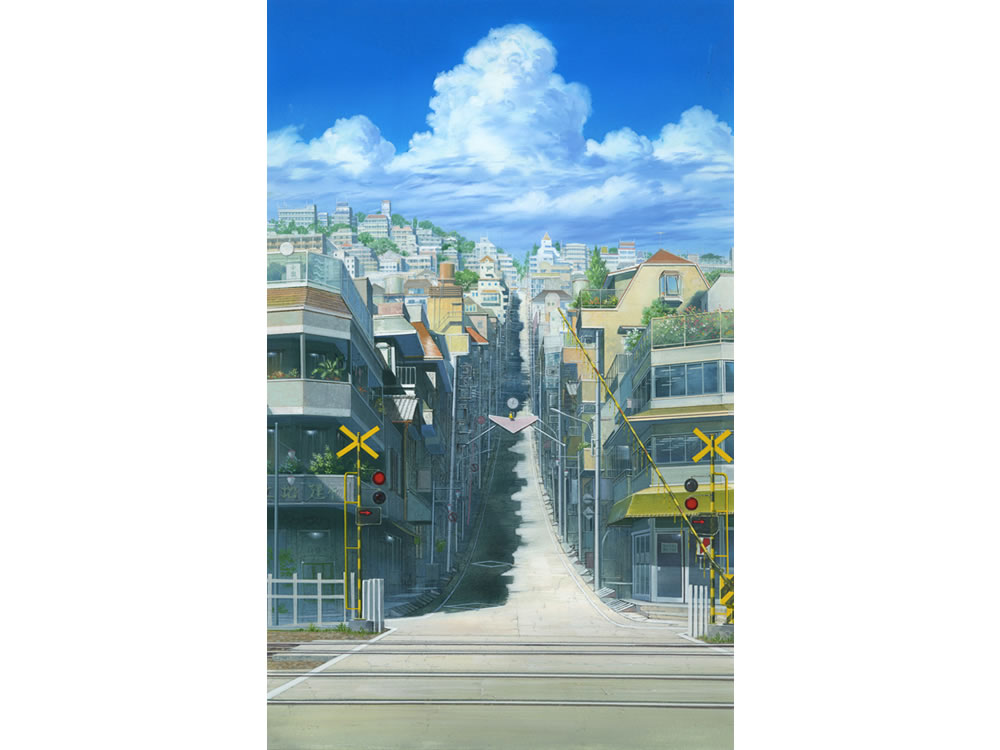 ≪Level crossing≫ from The Girl Who Leapt Through Time
≪Level crossing≫ from The Girl Who Leapt Through Time
© “Toki wo Kakeru Shojo” Production Committee 2006
Drawing based on actual scenery
To create backgrounds, Yamamoto often goes out to take photographs because he wants to feel the temperature, humidity, wind, light and atmosphere directly. He combines them with the photographs and incorporate them into the production. When he was working on Princess Mononoke (1997), he went to Yakushima to paint a dense, mysterious forest.
Iwaizumi noted that this way of composing background art for animations is similar to the technique of Chinese landscape painting, which combines actual landscapes of various regions to depict a foreign land. He also said that painting styles could differ according to environment even by the same painters. Northern Song paintings tend to be sharply defined due to low humidity. By contrast, Southern Song paintings are blurred due to high humidity.
In response to this remark, Yamamoto looked back on his six-month stay in Los Angeles, California. In the twilight hour, as rays of light shone through crisp and dry air, white buildings looked yellow and their shadows blue. He said, “If I live in the United States, my painting style will change.”
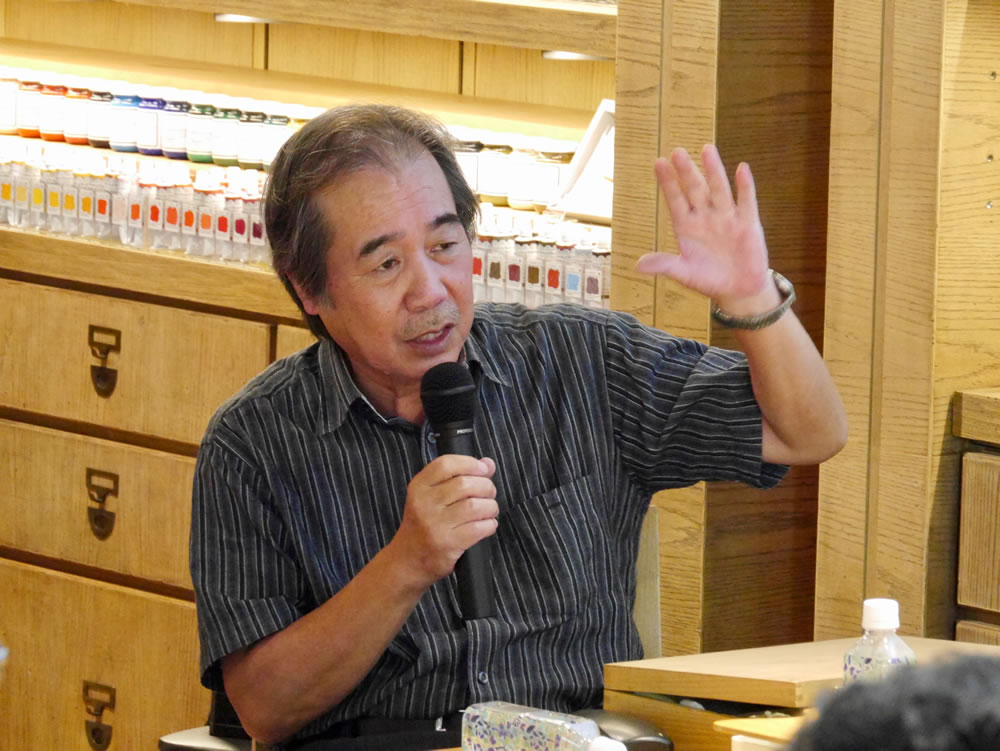 Yamamoto likes works by Sesshu and Hasegawa Tohaku. He has been drawing for 45 years using a traditional technique and poster paints.
Yamamoto likes works by Sesshu and Hasegawa Tohaku. He has been drawing for 45 years using a traditional technique and poster paints.
Varying clouds and skies depending on scenes
The talk moved onto how to draw clouds in animations. According to Yamamoto, he draws different types and shapes of clouds depending on seasons and scenes. “Cirrocumulus in late summer or early autumn is particularly difficult,” he said.
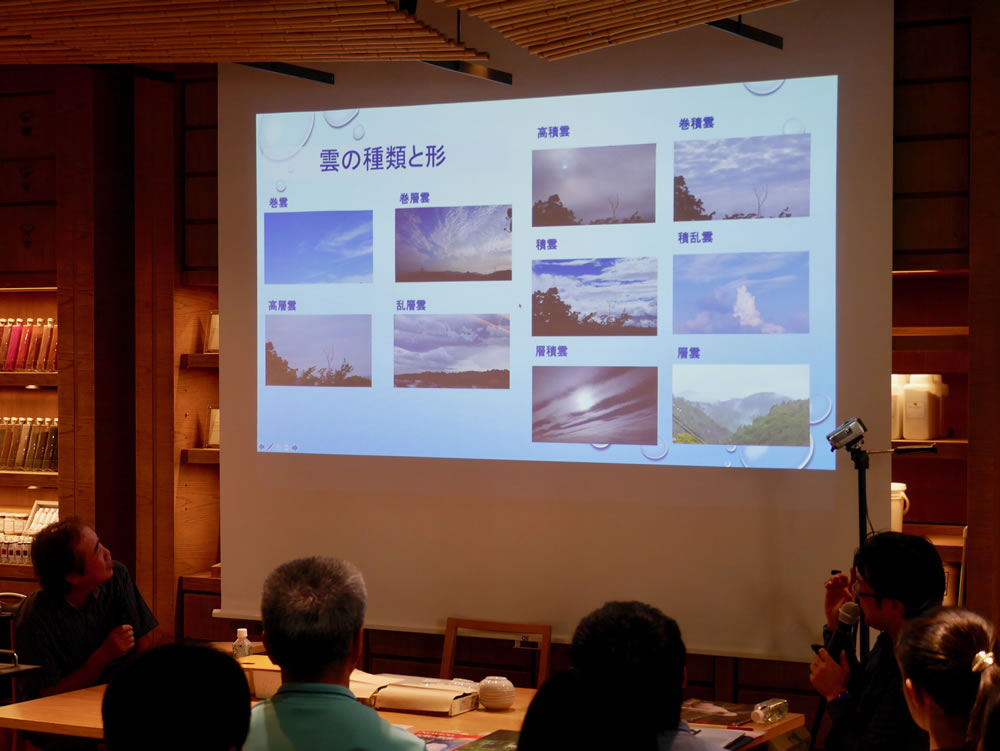 Yamamoto explained how to draw clouds while looking at photographs taken by Iwaizumi.
Yamamoto explained how to draw clouds while looking at photographs taken by Iwaizumi.
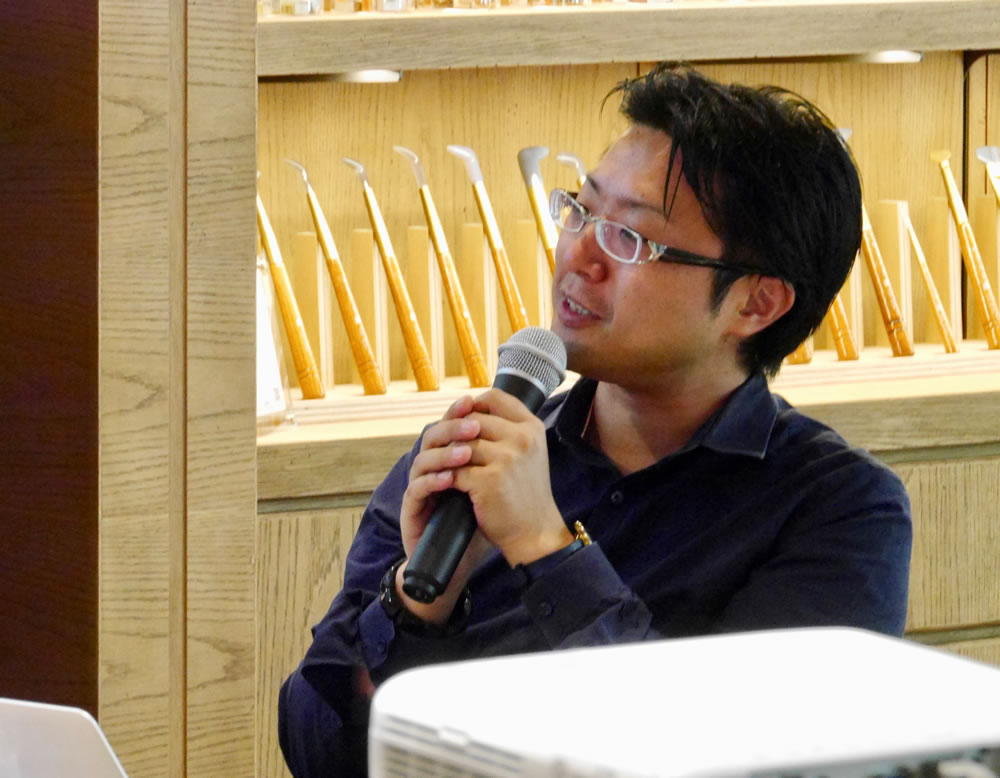 Kei Iwaizumi, Chief of PIGMENT TOKYO
Kei Iwaizumi, Chief of PIGMENT TOKYO
Iwaizumi said that stories of many animations seemed to take place in summer, when the sky would change drastically, for instance, with cumulonimbus and cirrus clouds. Yamamoto responded, “Most of animation audience are middle and high school students. Naturally, many animations depict typical boy-meets-girl stories. I suppose summer is somehow exhilarating and there are summer holidays.” Digressing from clouds and skies for a moment, Yamamoto said that he liked eating scenes, especially a scene from Whisper of the Heart (1995) in the winter background created by Yamamoto where the protagonist was slurping hot pot udon noodles with a friend’s grandfather warming themselves in a room.
As showing photographs of actual skies, Iwaizumi mentioned that clouds and skies vary by time of day. Yamamoto said he draws sunrise and sunset differently. They are similar in color but slightly different in tone. Yamamoto renders a sunset sky in smoggy color as the air is stale in the evening. He draws a sunrise sky in clear color as most of people are asleep during the night and the morning air is crisp and clear. “Sunsets in big cities are completely different from those in my hometown, Goto in Nagasaki Prefecture,” he added.
Yamamoto also differentiated skies even at the same time of day according to the characters’ feelings. The typical examples he cited were two sunsets from The Girl Who Leapt Through Time. In the scene where the protagonist was cheerful, he painted the sunset using a technique called dry brush that he learned in the United States. He first sprayed water with an airbrush, applied white paint as highlights using sakuyo-fude (a very fine brush for Nihonga, Japanese painting) and blurred with dry karabake (a wide brush for Nihonga). An airbrush was normally used to spray paint but some art staff members in the United States thought that would make the picture powdery and smoky and create an ominous atmosphere. They therefore developed the dry brush technique. In this technique, water was sprayed with airbrush to moisten the paper partly, paint was applied to the moistened area with a brush and the outline was blurred. Yamamoto learned about this technique when he was in the United States and began to use it in his production. In the scene where the protagonist was tearful, he painted in the traditional method and finished with karabake. He tried to create an embracing and soothing atmosphere.
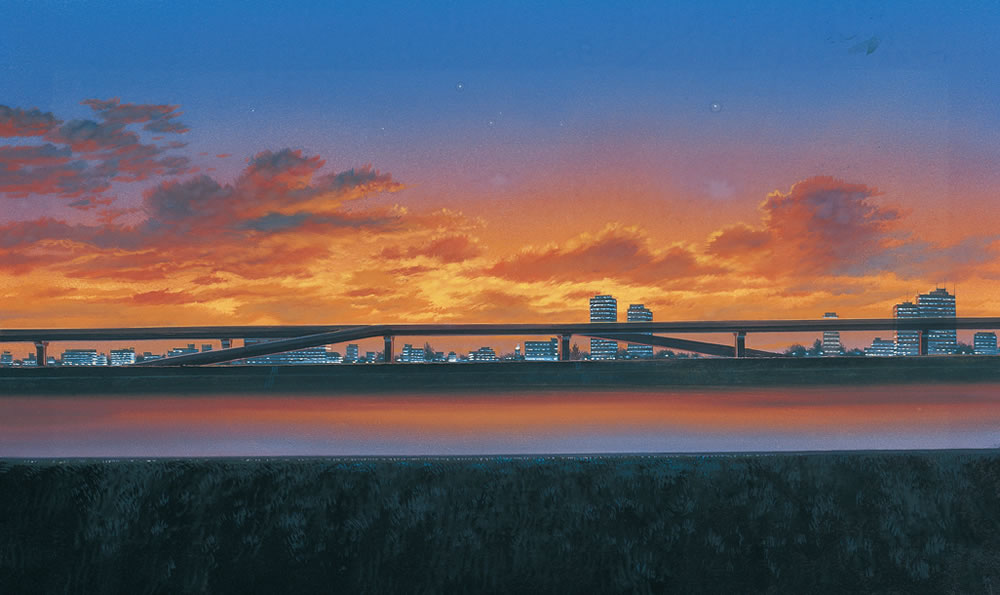 ≪Sunsets≫ from The Girl Who Leapt Through Time. Top: The protagonist is cheerful.
≪Sunsets≫ from The Girl Who Leapt Through Time. Top: The protagonist is cheerful.
Bottom: The protagonist is tearful. The two sunsets look distinctly different.
© “Toki wo Kakeru Shojo” Production Committee 2006
Nizo clouds painted during the session
During the demonstration, Yamamoto drew the sea of Iki he visited recently. He first applied water to the paper on both sides using a brush. He made about 10 colors by mixing paints. He first drew a sky and then clouds, sea and a sand beach. Tools he used were fine sakuyo-fude, hira-fude (flat brush) for watercolor and karabake used for Nihonga. He also demonstrated a drawing technique using a ruler when shading the clouds. He completed the picture in about one hour while he was talking about various techniques and “100 landscapes of Goto,” his lifework to draw 100 paintings of Goto.
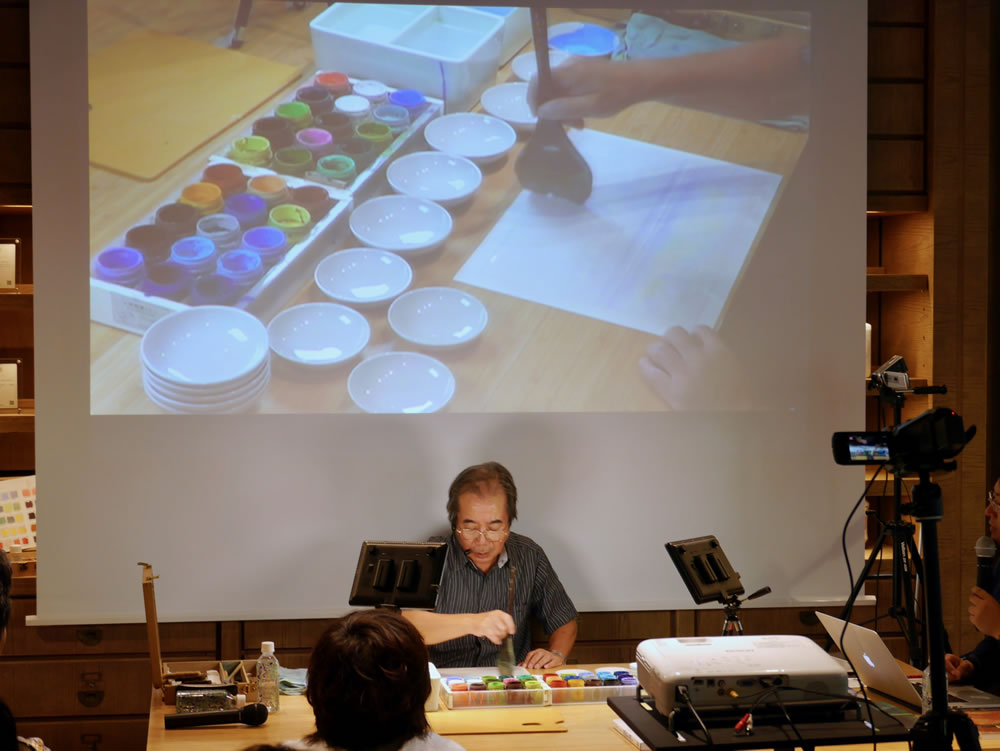 He applied water to both sides of paper with a brush. He said he would adjust the amount of water depending on season and time of day.
He applied water to both sides of paper with a brush. He said he would adjust the amount of water depending on season and time of day.
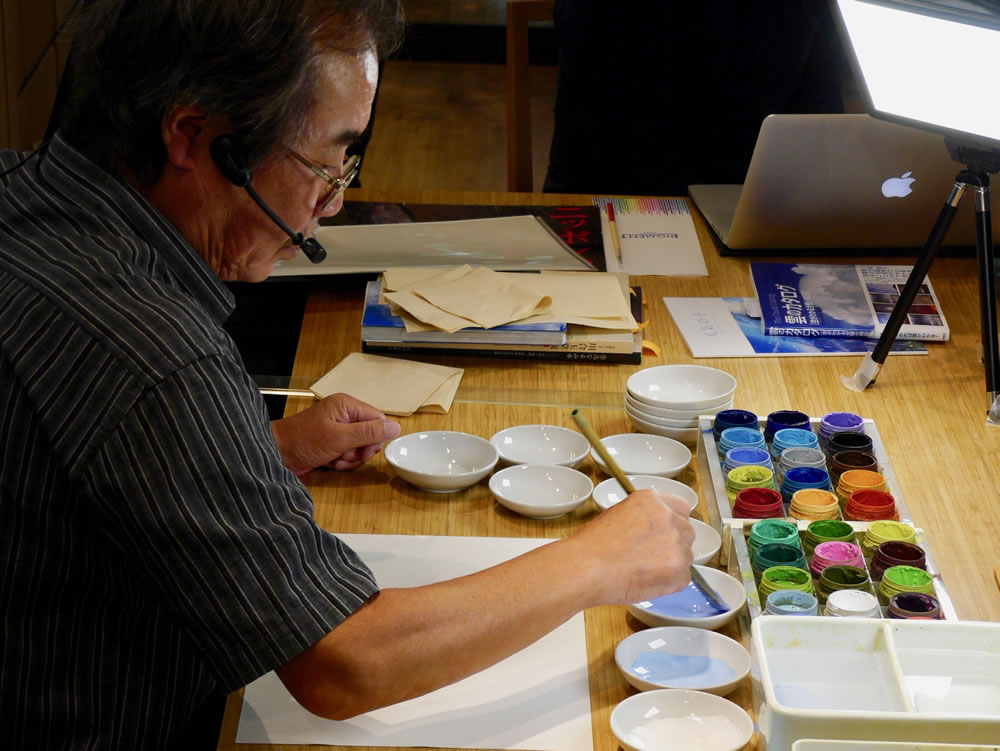 He mixed paints to create colors. He mixed four paints to make one color. That was to make vivid color a little subdued. He referred to Kazuo Oga, a master background artist just like Yamamoto, several times, making such a remark as “Oga may usually mix three paints.” He made about 10 colors during the session but he would usually make some 30 colors as there would be more motifs.
He mixed paints to create colors. He mixed four paints to make one color. That was to make vivid color a little subdued. He referred to Kazuo Oga, a master background artist just like Yamamoto, several times, making such a remark as “Oga may usually mix three paints.” He made about 10 colors during the session but he would usually make some 30 colors as there would be more motifs.
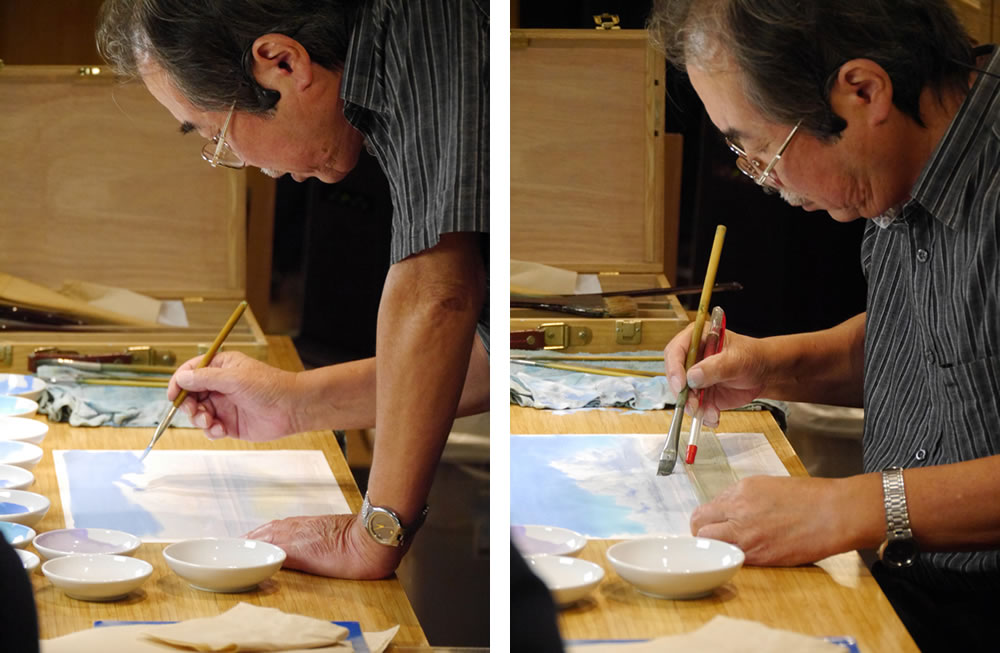 Left: Yamamoto sometimes remain standing while painting. He said, “We used to get reprimanded if we did not remain standing.” Iwaizumi added, “You can get a better view of the entire picture when you are standing.”
Left: Yamamoto sometimes remain standing while painting. He said, “We used to get reprimanded if we did not remain standing.” Iwaizumi added, “You can get a better view of the entire picture when you are standing.”
Right: He shaded clouds and drew waves using the groove of a ruler. He held a brush and a rod (Yamamoto used a ball-point pen) in the same way as holding chopsticks, inserted the rod in the groove of a ruler and moved the rod and the brush horizontally. As the rod ran in the groove, the brush moved stably along the ruler. Yamamoto also used karabake to blur paint. Karabake was originally used for Nihonga. Iwaizumi said, “The technique of using the brush has not been handed down to the present generation. It is like an endangered species in the world of Nihonga.”
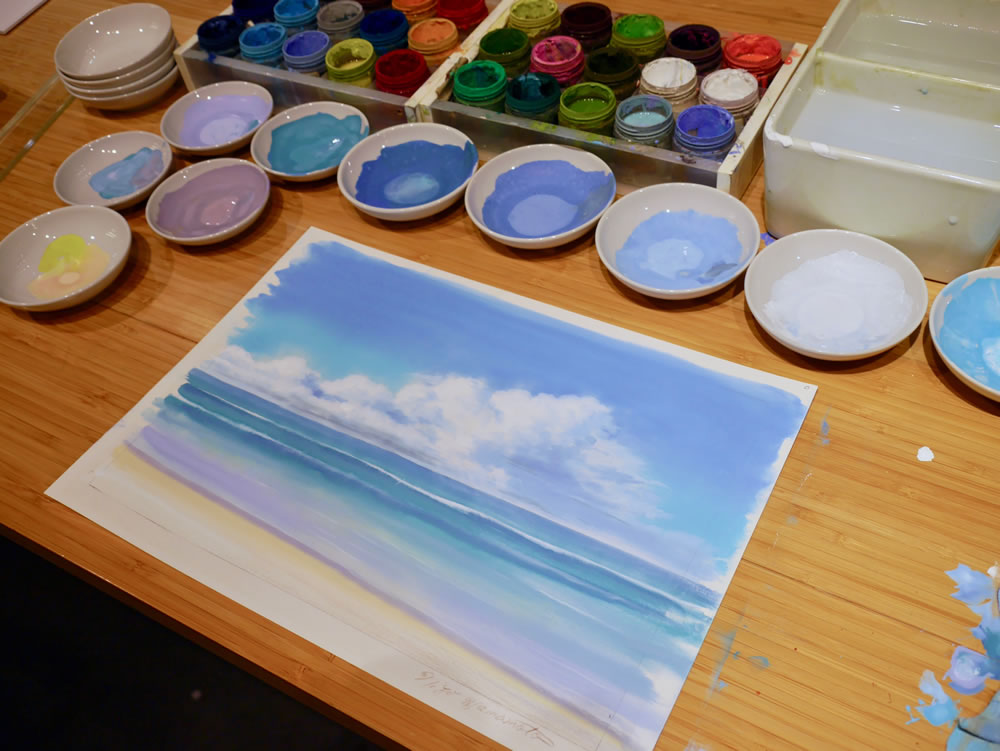 The sea of Iki with summer clouds floating across the sky. Different tones and textures of blue are used for clouds, sky and waves.
The sea of Iki with summer clouds floating across the sky. Different tones and textures of blue are used for clouds, sky and waves.
This talk session showed that there are tremendous variations in the way clouds and skies are depicted. I could imagine Yamamoto working on each scene while staying considerate towards the story. It was amazing to see the process of creating a vivid depiction of a beach in the summer sun with clouds floating over the horizon only in one-hour demonstration. Besides clouds and skies, Yamamoto drew various scenes in the films, such as a folksy old town of Osaka in Downtown Story: The Movie (1981), towns in flames by an air raid in Grave of the Fireflies (1988) and the mystical forest of Shishigami, the forest spirit, in Princess Mononoke. All of those scenes must have been created after careful deliberation about the stories and the characters’ feelings. The talk session was meaningful. It offered a rare glimpse of the world of background art, which tends to attract less attention than characters.
(note)
*“Otsuka water” and “Tomonaga propeller” are depictions characteristic of the animators Yasuo Otsuka and Kazuhide Tomonaga, respectively.
Nizo Yamamoto (art director of animation films)
Born on June 27, 1953 in Goto, Nagasaki Prefecture. He has been always good at drawing since his childhood. After studying architecture at high school in Gifu Prefecture, he went to a technical college on art in Tokyo. While in college, he started working for an animation art studio. He served for the first time as art director of Conan, the Boy in Future (1978), Hayao Miyazaki’s first animated TV series. After that, he participated as art director in production of many successful animations, such as Castle in the Sky (1986), Grave of the Fireflies (1988) and Princess Mononoke (1997). In 2006, he won Grand Prize / Internal Affairs and Communications Minister’s prize at the 12th AMD Award ’06 as art director of The Girl Who Leapt Through Time. In the summer of 2011, “Nizo Yamamoto exhibition – a creator of Japan’s animation art” was held at Kobe City Museum. The exhibition was a success, attracting some 85,000 visitors. The exhibition started to be toured nationwide and the visitors totaled more than 750,000. The exhibition is still on a tour as of 2019. He has written many books including art books. In July 2018, Yamamoto Nizo Museum opened in the city of Goto, Yamamoto’s hometown. He serves as Goto City Ambassador, a visiting professor on Anime Direction Course at Kyoto University of Art & Design, and a teacher at Tokyo Animation College.
Kaieisha http://www.yamamoto-nizo.com/
Kei Iwaizumi (Chief of PIGMENT TOKYO, Art Material Expert)
Completed a doctoral degree in art at Kyoto University of Art & Design. Full-time lecturer on Japanese Painting Course at Kyoto University of Art & Design. In 2015, he received a doctoral degree with his dissertation on the usage of nikawa (hide glue) in painting. While researching and teaching about nikawa at PIGMENT TOKYO and Kyoto University of Art & Design, he is also active as an artist on the theme of the existence of substances.
PIGMENT COLOR PHILOSOPHY Vol. 5
Colors of clouds and skies
~ scenes created by analog coloring ~
Date: Saturday, August 10, 2019, 4:00PM to 6:00PM
Location: PIGMENT TOKYO
TEL: 03-5781-9550
Address: TERRADA HarborOne Bldg. 1F, 2-5-5 Higashi-Shinagawa, Shinagawa-ku, Tokyo 140- 0002 Japan
Access: About 3-minute walk from Tennoz Isle station on the Rinkai line or 5-minute walk from Tennoz Isle station on the Tokyo Monorail
*4,104 yen including a copy of autographed book Yamamoto Nizo Fukei o Egaku (Nizo Yamamoto paints landscapes) (published by Bijutsu Shuppan-sha Co., Ltd. in 2013). The number of available copies is limited.
https://pigment.tokyo/?set_language=en
*URL link confirmed on May 1, 2020.












